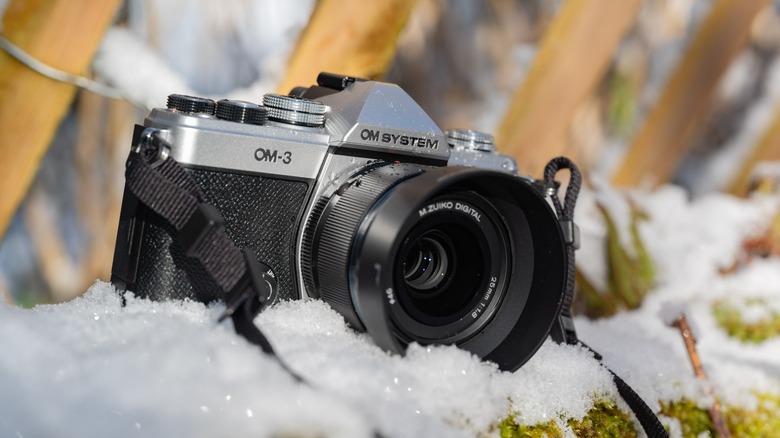OM System announced its new retro-inspired Micro 4/3 OM-3 mirrorless camera today, and I had the opportunity to take it out into the field to snap some photos with it in preparation for an upcoming full review. With the recent popularity of retro-styled mirrorless cameras, such as the Nikon Zf and Fujifilm X100IV, the OM-3 could offer some advantages as a highly compact M4/3 option.
Advertisement
Right out of the gate, I found myself appreciating the slim profile of the OM-3, as well as how lightweight it is at around 400 grams before lenses. I’m used to carrying heavy full frame gear most of the time, but even with a lens attached, the OM-3 weighs less than most of the full frame lenses I’m accustomed to. I was able to have it with me while I did the morning farm chores and snap photos of the goats, something which would be awkward with a larger setup. Despite its slim profile, I found it to be surprisingly comfortable to hold, and I like the feel of the grip.
The materials and overall build quality seems to be excellent, with the retro style control dials being particularly nice to use. However, I would prefer to have dedicated shutter speed, ISO, and exposure compensation dials with markings in order to adjust settings without having to look at the screen. With that said, I have quickly gotten used to the control scheme, even in the brief time I’ve so far spent with the camera. I do like to see the familiar OM System fully articulating display here, and the viewfinder is sharp and bright.
Advertisement
Good first impressions
While it’s certainly too early for me to offer a definitive conclusion of the OM-3’s image quality from its 20.37MP sensor, I’m happy with the initial photos I’ve captured with it. I like the way it renders colors, and the JPEGs look good. Due to this still being a pre-launch product, as of this writing, Lightroom has not been updated to be compatible with OM-3 RAW files, which has limited my evaluation of the camera.
Advertisement
One very cool and somewhat unique feature of the OM-3 is its dedicated front dial for selecting different filters and adjusting color. There are a lot of customizable options to choose from, and I’ve only started to play around with it, but I’m already really impressed by the in-camera creative potential it offers, and it may be superior to competing brands that offer similar functions.
Autofocus seems accurate and fast, and is easy to customize on the fly. Subject detection worked well on my cats, dogs, and goats, and it feels very similar to the excellent AF system in the OM-1 Mark II — which is certainly a compliment given how impressed I was with the autofocus in that camera. Additionally, stabilization seems to be as impressive as ever in OM System cameras, with between 5.5 and 7.5 stops of stabilization depending on what lens you’re using.
Advertisement
Battery life is hard to evaluate in the short time I’ve so far spent with the OM-3, but the battery didn’t drain too much after an hour or two snapping photos in the sub-freezing temps of early morning. The various useful computational photography features for which OM Systems is known for, such as Live ND, are also in the OM-3.
Price, availability, and several new lenses
I’m testing the OM-3 alongside a new lens from OM System — the M.ZUIKO Digital ED 25mm f/1.8 II. This offers the equivalent focal length of a 50mm lens on an M4/3 sensor, which makes it a nice, bright standard lens to use with the OM-3. It’s very compact, and seems very sharp with attractive bokeh. Also announced are the M.ZUIKO DIGITAL 17mm F1.8 II and M.ZUIKO DIGITAL ED 100-400mm F5.0-6.3 IS II lenses.
Advertisement
The OM System OM-3 will ship in late February, starting at $1,999. It will also be available in a bundle with the M.ZUIKO Digital ED 12-45mm F4 PRO lens for $2,299. The M SYSTEM M.ZUIKO DIGITAL ED 100-400mm F5.0-6.3 IS II will retail for $2,299, while the M.ZUIKO Digital ED 25mm f/1.8 II will cost $499, and the 17mm F1.8 II will have an MSRP of $499. An additional discount of $200 in the U.S. will be available if you purchase the 25mm or 17mm lens with an OM system camera.














